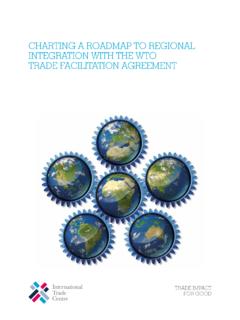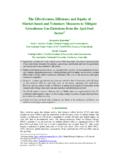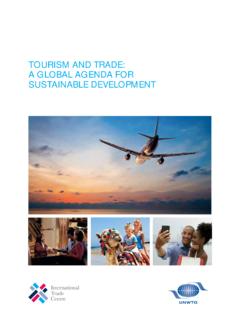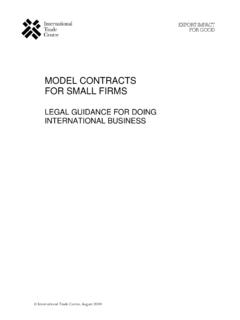Transcription of FOOD SAFETY AND GOOD HYGIENIC PRACTICES HANDBOOK …
1 FO O D SAFETY AN D G O O D H YG IEN IC PRAC TIC ES H AN D BO O K FO R G AMBIAN YO U TH EN TREPREN EU RS INTERNATIONAL TRADE CENTRE ii October 2017 Banjul, and Geneva Under the supervision of Khemraj Ramful, Senior Adviser, Export Quality Management, this guide on food SAFETY has been prepared by Hema Menon, Trade Training Officer, at the International Trade Centre, in partnership with The Food SAFETY and Quality Authority of The Gambia (FSQA) and as part of The Gambia: youth Empowerment Project (YEP), financed by the European Union. For more information on this guide, contact: Mr. Khemraj Ramful Senior Adviser, Export Quality Management Trade Facilitation and Policy for Business Email: Telephone: +41 22 730 04 87 International Trade Centre 54-56 Rue de Montbrillant 1202 Geneva, Switzerland I: T: For more information on YEP, contact: Ms.
2 Fatou Jallow YEP Project Coordinator and Senior Technical Adviser, Email: Tel. +220 3616993; +220 9662895 International Trade Centre Sait Matty Road, Bakau The Gambia F: I: T: Copyright images Shutterstock, FAO, ITC. The designations employed and the presentation of material in this document do not imply the expression of any opinion whatsoever on the part of the International Trade Centre concerning the legal status of any country, territory, city or area or of its authorities, or concerning the delimitation of its frontiers or boundaries. Mention of firm names does not imply endorsement. This document has not formally been edited by the International Trade Centre. INTERNATIONAL TRADE CENTRE iii Foreword Food, with water and air, is the very basis of life. It is our source of nutrition, growth and health.
3 It not only has socio-cultural significance, but also considerable economic and developmental ramifications. The United Nations Sustainable Development Goals 1, 2, and 3 (No poverty, Zero hunger, and Good health and well-being) depend directly on the sufficient availability and affordability of safe and nutritious food. Due to its universality, and relatively lower start-up costs and investments involved, food offers enormous opportunities for entrepreneurs, and business start-ups in food are very common. At the same time any food operator or business has the responsibility to ensure that the food it supplies will not cause harm to the consumers . Unsafe or unhygienic food can make people very sick, spread diseases, and may even cause death. Due to this, food is also a highly regulated sector where governments assume the responsibility to safeguard the health and SAFETY of their population through laws that set down conditions and parameters for food business operators and their operations.
4 The cost of disease, sickness and premature death takes a heavy toll not only in terms of medical care, but also socially and economically in terms of lost productivity and potential. Food SAFETY is the foundation of trust in the food business. Entrepreneurs can establish a good reputation built on food SAFETY and quality and derive profit. Small and medium-sized businesses very often do not realize that not applying food SAFETY and quality improvement measures turns out to be more expensive than applying them. In this regard, while hindsight may be good, foresight is better. This means not leaving this important element to chance, or ignoring it, but to actively and alertly plan, implement and pursue food SAFETY from the initial stage of food production, inputs, processing, packaging, storing, distribution.
5 This guide on food SAFETY has been prepared for Gambia s youth entrepreneurs to support employment generation, micro and small-sized enterprise creation and growth efforts under the youth Empowerment Project. The programme, INTERNATIONAL TRADE CENTRE iv financed by the European Union, is being implemented by the International Trade Centre in partnership with the Government of Gambia. The project aims to contribute to the economic development of The Gambia through direct support to the development of the local economy by enhancing employability and self-employment opportunities for youth . With 60% of Gambia s population below 25 years of age, the project focuses on vocational training and the creation of micro and small-sized enterprises, and creating and improving employment opportunities for youth in selected sectors through value addition and internationalization.
6 We hope this guide will inspire young Gambians to adopt and implement a food SAFETY and quality-based excellence approach to their food business endeavours, and contribute to their success. Khemraj Ramful Senior Adviser, Export Quality Management International Trade Centre CONTENTS CHAPTER I: INTRODUCTION TO FOOD SAFETY 1. Introduction .. 2 2. Food SAFETY .. 3 3. Quality in food .. 4 4. Food hazards .. 7 Types of hazards .. 8 Managing hazards .. 12 5. Food SAFETY and quality systems .. 15 Benefits of quality systems in food .. 17 Disadvantages of not applying quality systems .. 17 Common food SAFETY system requirements .. 18 Main steps in meeting food SAFETY system requirements .. 21 6. Five keys to safe food .. 22 CHAPTER II: GOOD AGRICULTURAL PRACTICES (GAP) 1. Basic concepts in GAP .. 28 Overview of GAP implementation points.
7 29 INTERNATIONAL TRADE CENTRE vi 2. Benefits of GAP .. 31 3. Implementing GAP .. 32 Workers .. 32 Land .. 35 Water .. 38 Crops .. 39 Fertilizers, pesticides, agro-chemicals .. 40 Animals .. 45 Harvest .. 45 Transport .. 46 Traceability .. 47 CHAPTER III: GOOD HYGIENIC PRACTICES (GHP) - CODEX GENERAL PRINCIPLES OF HYGIENE 1. Introduction to GHP .. 51 2. Building and equipment .. 54 Location of premises .. 54 Location of equipment .. 57 Internal structures and fittings .. 58 3. Design and layout of premises .. 62 Layout .. 62 INTERNATIONAL TRADE CENTRE vii 65 Equipment .. 66 Facilities .. 71 4. Control of operations .. 76 Incoming materials .. 79 5. Personal hygiene .. 86 6. Cleaning and maintenance .. 90 Repair and maintenance .. 90 7. Transportation .. 97 8. Product information .. 99 9. Training .. 101 CHAPTER IV: FOOD SAFETY SYSTEMS 1.
8 Introduction .. 104 2. Hazard Analysis and Critical Control Points (HACCP) .. 104 HACCP Concept .. 105 HACCP Key terms .. 107 HACCP implementation .. 109 3. ISO 22000: Food SAFETY Management System .. 120 INTERNATIONAL TRADE CENTRE viii Relationship between ISO 22000 and HACCP .. 120 Steps in implementing ISO 22000 .. 122 Costs and benefits of ISO 22000 .. 125 4. British Retail Consortium (BRC) Standard .. 127 ANNEXES ANNEX 1: Example of a staff training record form .. 132 ANNEX 2: Stock rotation .. 134 ANNEX 3: Receiving deliveries .. 138 ANNEX 4: Approved supplier list .. 140 ANNEX 5: Food recall and withdrawal management .. 143 ANNEX 6: Finished product analysis .. 147 ANNEX 7: Agricultural 150 ANNEX 8: Good storage PRACTICES .. 151 ANNEX 9: An example of a processing plant sanitation master schedule .. 153 CHAPTER I: INTRODUCTION TO FOOD SAFETY CHAPTER I: INTRODUCTION TO FOOD SAFETY INTERNATIONAL TRADE CENTRE 2 1.
9 Introduction People all over the world often get sick from the food they eat everyday. This sickness is called foodborne disease and is caused by dangerous microorganisms and/or toxic chemicals. Foodborne diseases affect both developing and developed countries, and affect the elderly, and children most causing strain on the health system. With more people travelling, and food supply chains increasingly becoming global, foodborne diseases, like other diseases, have the potential to spread widely. However, most foodborne disease is preventable with proper food handling and attention to good PRACTICES and hygiene. This chapter will allow you to acquire the basic concepts and terms associated with food SAFETY and quality. It will then provide you with the fundamental hazard types and a preliminary introduction to risk assessement, main methods of food SAFETY management, and why it is important to make safe food.
10 Finally, the chapter with take you through the main steps involved in meeting food SAFETY requirements, and the 5 keys to food SAFETY . CHAPTER I: INTRODUCTION TO FOOD SAFETY INTERNATIONAL TRADE CENTRE 3 2. Food safetyFood SAFETY is about producing, handling, storing and preparing food in a manner that prevents infections or diseases and retains enough nutrients for a healthy diet. Unsafe food is that which has: been exposed to dirt and germs and is contaminated, or gone bad and is rotten, or contains toxic physical, chemical or biological substances, and can harm the health of the person while eating. Eating unsafe food can make people very sick and can even cause death. Producing safe food is essential: to protect consumers from the hazards of foodborne illnesses to increase competitiveness in both the domestic and international markets.










